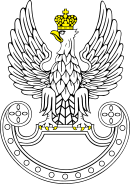Polish army
| Land Forces Wojska Lądowe |
|
|---|---|

Eagle of Polish Land Forces
|
|
| Active | 1918–present |
| Country |
|
| Allegiance | Polish Armed Forces |
| Branch | Land Forces |
| Size | (77,000 military) 1,010 Tanks 3,110 IFV/APC 250 Helicopters |
| Headquarters | Warsaw |
| March | Yes |
| Engagements |
Polish–Ukrainian War Polish–Czechoslovak War Polish–Soviet War Polish–Lithuanian War World War II War in Iraq War in Afghanistan EU Force Chad/CAR |
| Commanders | |
| Commander | Lieutenant General Zbigniew Głowienka |
| Chief of Staff | Major General Andrzej Malinowski |
| Insignia | |
| Flag |  |
| Banner of the Commander in Chief |  |
The Land Forces (Wojska Lądowe) are a military branch of the Armed Forces of the Republic of Poland. They currently contain some 65,000 active personnel and form many components of European Union and NATO deployments around the world. Poland's recorded military history stretches back for hundreds of years – since the 10th century (see List of Polish wars and History of the Polish Army), but Poland's modern army was formed after 1918.
When Poland regained independence in 1918, it recreated its military which participated in the Polish-Soviet War of 1919–1921, and in the two smaller conflicts ( Polish-Ukrainian War (1918–1919) and the Polish-Lithuanian War (1920)).
Initially, right after the First World War, Poland had five military districts (1918–1921):
The Polish land forces as readied for the Polish-Soviet War was made up of soldiers who had formerly served in the various partitioning empires, supported by some international volunteers. There appear to have been a total of around 30 Polish divisions involved. Boris Savinkov was at the head of an army of 20,000 to 30,000 largely Russian POWs, and was accompanied by Dmitry Merezhkovsky and Zinaida Gippius. The Polish forces grew from approximately 100,000 in 1918 to over 500,000 in early 1920. In August 1920, the Polish army had reached a total strength of 737,767 people; half of that was on the frontline. Given Soviet losses, there was rough numerical parity between the two armies; and by the time of the battle of Warsaw Poles might have even had a slight advantage in numbers and logistics.
Among the major formations involved on the Polish side were a number of Fronts, including the , and about seven armies, including the First Polish Army.
...
Wikipedia
